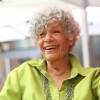Updated Jan. 24 at 2:35 p.m.
Last night, the Boston Society of Architects held their annual awards ceremony for the prestigious Harleston Parker Medal. The medal honors the most beautiful building, monument or structure in metro Boston within the last 10 years. This year's winner was Janet Echelman for "As If It Were Already Here" — the first artwork to win in the 99-year history of the awards as well as the first temporary or ephemeral work. You may remember the piece hanging over the Rose Kennedy Greenway in downtown Boston back in 2015. The structure was made from rope and twine, connected by half a million nodes and reaching 600 feet above the city as it danced in the wind. Janet Echelman joined All Thing's Considered's Arun Rath for a conversation about the piece. This transcript has been lightly edited.
Arun Rath: Thanks so much for being here, and congratulations.
Janet Echelman: I'm so delighted to be here, Arun. I can't tell you how shocked I was. I never imagined that an artist or an artwork would receive this recognition, especially from the Boston Society of Architects. I am especially delighted because the artwork itself had a temporary lifespan that was entirely within 2015. The fact that they're still thinking about it and nominating it and recognizing it means that a work can live robustly in our minds.
Rath: Clearly it must have for this award to be given. I want to talk more about the award. But first, especially for people who may not have been here in 2015, I'd love if you could talk a bit more about how it appeared, and what the work was meaning to represent.
Echelman: Well, if you came up out of I-90 or walked along the street in downtown Boston, along the ribbon park of the Boston Greenway and looked up, you would have seen a knotted sculpture made for more than 100 miles of twine. It stretched to the 28th story of International Place, and it spanned more than 600 feet from International Place across to the Intercontinental Hotel. Its colors were recalling what had been here in the past: the central artery, which was nicknamed "the largest parking lot in the world," and was buried in the Big Dig. So this work is very much about the layers of history here in Boston and the fact that we can reimagine our physical world and make it so. What I learned is that not only had the city of Boston built the artery and then buried it in a tunnel, but the land that you walk on when you walk along the grass of the Greenway is in fact landfill that was created by chopping down the tri-mountain, the three mountains, centuries ago. We know the street, Tremont Street, today. And we forget that there was a tri-mountain that once graced this part of the city. And so "As If It Were Already Here," its title is in the subjunctive tense because it's about imagining things that don't exist and making them real.
Rath: Hearing that is making me think about how it recalls how the city itself is ephemeral and its why we rebuilt the city many times over history.
Echelman: That is absolutely true. I remember when the sculpture was here, a curator walked up to me and he said when he saw the sculpture stretching across between private buildings that he no longer could say anything is impossible. And that, for me, is the goal of an artwork. If it makes us question the status quo, if it makes us think about what could be possible. When you look around at the city, it's made of straight edges and hard materials, and suddenly my sculpture is soft and fluidly moving in the wind. It's porous, so the wind moves through it and it billows and ripples and changes at every moment and in the rain, at sunset, at every time of day, it's completely different. It goes into silhouette. It changes and becomes almost ghostlike in its translucency at certain times of day. And then when the sunlight strikes it, it becomes vivid and bright in orange and red and green and white, and the stripes that make up the tapestry of the artwork, the 600-foot, 28-story tall artwork. Those stripes recall the lanes of the highway, which no longer run, which are buried underneath your feet.
Rath: You mentioned being shocked to get this award. And again, this is eight odd years on from when it was up and it has never been given to a non-permanent structure before. How out of the blue was this? When did you find out about it?
Echelman: Well, last night at the award ceremony. In fact, the work had been nominated on multiple years. So I really never thought it would ever be recognized by this esteemed group of architects. And I'm really moved by this. I learned that it was it took four rounds of voting and that at the end, the final question was, what is the most beautiful thing you've seen today? And then it was unanimous. I also am delighted that beauty in and of itself is also being recognized because that's something that oftentimes gets lost, especially in the art world today. And I think that we all need rejuvenation and to be refreshed in our spirits. And I think that beauty is a worthy pursuit for artists and architects alike.
Rath: Janet, it's been such a pleasure speaking with you. It's hard to talk about art and architecture. You did it so beautifully. Thank you so much.
Echelman: Well, it's a delight. And for me, receiving this award for a work that is no longer physically there really highlights how our environment and beauty in the public setting can enrich our lives and live on robustly in our memories. So thank you.
Echelman says she is now preparing new art installations for cities across the country and is serving as a distinguished visiting artist at at the Massachusetts Institute of Technology.
Correction: This story was updated to correct a misspelling of Echelman’s last name.






